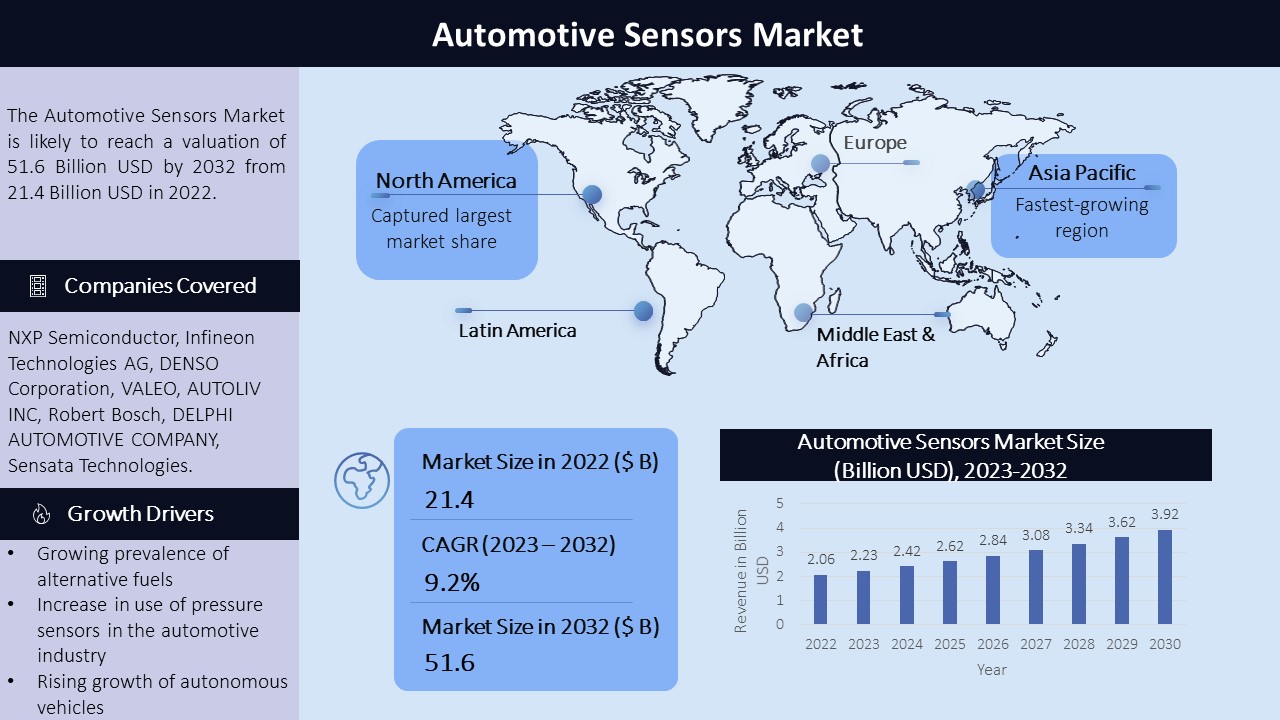Automotive Sensors Market By Sensor Type (Temperature Sensor, Pressure Sensor, Speed Sensor, Position Sensor, Others); By Application (Powertrain, Chassis, Body Electronics, Safety & Security, Telematics); By Region (North America, Europe, Asia Pacific, Latin America, Middle East & Africa) - Global Market Analysis, Trends, Opportunity and Forecast, 2022-2032
Automotive Sensors Market
Automotive sensors are smart sensors, which can be used to control and process temperature, coolant level, and pressure of oil in a vehicle. There are several types of sensors used in the automotive industry such as speed sensors, coolant sensors, temperature sensors, pressure sensors, magnetic sensors, voltage sensors, and oxygen sensors. The automotive sensor is one of the fastest-growing technologies in the original equipment manufacturer (OEM) section, especially in North America.
Automotive Sensors MarketSize and Share
The market size for Automotive Sensors Market was USD 21.4 billion in the year 2022. It is expected that the market size for Automotive Sensors will increase by approximately USD 51.6 billion by 2032 as the market for Automotive Sensors is continuously growing at a compound annual growth rate (CAGR) of 9.2% during the forecast period 2023-2032.
Automotive Sensors Market Report Scope |
|
|
Base Year Market Size |
2022 USD 21.4 billion
|
|
Forecast Year Market Size
|
2032 USD 51.6 billion |
|
CAGR Value
|
9.2% from 2023 to 2032 |
|
Segmentation
|
|
|
Challenges
|
|
|
Growth Drivers
|
|
Automotive Sensors Market Key Drivers
Various factors help in the growth of the Automotive Sensors Market. They are as follows:
- Growing prevalence of alternative fuels: Any technology utilized to power an engine without using petroleum is known as an alternative fuel vehicle (e.g., electric vehicles, hybrid electric vehicles, solar-powered vehicles). Growing adoption of alternative fuels (e.g., gasoline or diesel) and vehicles will lower consumption gasoline costs, reduce emissions, and improve national energy security. It will drive the market for automotive sensors.
- Increase in the use of pressure sensors in the automotive industry: Modern vehicle restraint systems utilize side airbag pressure sensors to satisfy passenger car safety requirements. The pressure sensor is integrated into the vehicle’s side doors and sends digital crash signals to the central airbag unit. Furthermore, the air pressure sensor improves engine efficiency by effectively controlling spark advances in gasoline and diesel engines. Hence, the market is expected to develop due to the rising use of pressure sensors in the engine and the vehicle’s safety system.
- Rising growth of autonomous vehicles: Automotive Sensors Market is primarily driven by the rising adoption of autonomous vehicles around the world growing need to reduce greenhouse gas emissions, and the increasing demand for high-quality security, and tracking systems in vehicles.
Automotive Sensors Market Challenges
Many challenges are faced by Automotive Sensors Market. They are listed below:
- High development cost: Because of the small quantities produced, it is impossible to reduce the cost of sensors used in advanced driver assistance systems to target levels.
- The underdeveloped aftermarket for automotive sensors in emerging economies: The automotive sensors business is an OEM-dominant business because of the underdeveloped aftermarket for automotive sensors. For various other business segments, such as industrial sensors and home automation electronics, the aftermarket plays a vital role in promoting market growth. However, in terms of automotive sensors, technical specifications for sensors are given by the vehicle manufacturer or a tier 1 supplier, which is the primary reason behind the difficulty in the commercialization of automotive sensors.
- Safety and security threats in autonomous vehicles: There have been multiple fatal incidents in Level 3 to Level 5 autonomous vehicles, wherein vehicles had limited human interaction. Moreover, the EU Agency for Cybersecurity (ENISA) and Joint Research Centre (JRC) released a report that autonomous vehicles are susceptible to adversarial risks.
Automotive Sensors Market Regional Synopsis
- North America; The North American automotive sensors market is expected to grow at the fastest CAGR from 2022 to 2032. This is due to the increasing population, technological advancements, and the rising income of consumers.
- Europe: Europe Automotive Sensors market accounts for the second-largest market share due to the increasing demand for vehicles. Further, the German automotive sensors market held the largest market share, and the UK automotive sensors market was the fastest-growing market in the European region.
- Asia-Pacific: Asia-Pacific held a major market share in terms of revenue during the forecast period. A rise in vehicle sales across the region is likely to increase the demand for sensors in the vehicle. The rise in demand for electric vehicles across the region is also propelling the market growth. The presence of manufacturing industries across China, India, and Japan is creating market growth opportunities.
- LAMEA: Latin America, the Middle East, and Africa markets are growing moderately compared to the other regions.

Automotive Sensors Market Segmentation
The Automotive Sensors Market is segmented into various categories which are listed below:
By Sensor Type
- Temperature Sensor
- Pressure Sensor
- Speed Sensor
- Position Sensor
- Others
By Application
- Powertrain
- Chassis
- Body Electronics
- Safety & Security
- Telematics
By Region
- North America
- Europe
- Asia-Pacific
- LAMEA
Automotive Sensors Market Key Players
- NXP Semiconductor
- Infineon Technologies AG
- DENSO Corporation
- VALEO
- AUTOLIV INC
- Robert Bosch
- DELPHI AUTOMOTIVE COMPANY
- Sensata Technologies
- CONTINENTAL AG
- STMicroelectronics N.V
- Others

Need Customized Report for Your Business ?
Utilize the Power of Customized Research Aligned with Your Business Goals
Request for Customized Report- Quick Contact -
- ISO Certified Logo -

















